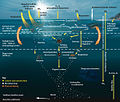Carbon cycle
Carbon Cycle
The carbon cycle is the biogeochemical cycle by which carbon is exchanged among the biosphere, pedosphere, geosphere, hydrosphere, and atmosphere of the Earth. It is one of the key life processes that sustain life on Earth.
Overview[edit]
Carbon is the main component of biological compounds as well as a major component of many minerals. Carbon also exists in various forms in the atmosphere. Carbon in the Earth's atmosphere exists in two main forms: carbon dioxide and methane. Both of these gases capture heat from the sun and keep it from escaping back into space, contributing to the greenhouse effect.
Process[edit]
The carbon cycle involves several key steps. First, carbon dioxide in the atmosphere is absorbed by plants and algae through the process of photosynthesis. These organisms convert carbon dioxide into organic compounds, such as sugars, which can be used for energy. When these organisms die, their bodies decompose, releasing the carbon back into the atmosphere or into the soil. Some of the carbon in the soil can be stored for long periods of time in the form of fossil fuels.
Human Impact[edit]
Human activities, such as the burning of fossil fuels and deforestation, have significantly altered the carbon cycle. These activities release large amounts of carbon dioxide into the atmosphere, contributing to global warming and climate change.
See Also[edit]
References[edit]
<references />

This article is a environment-related stub. You can help WikiMD by expanding it!
Carbon_cycle[edit]
-
Carbon cycle
-
NASA - A Year in the Life of Earth's CO2
-
Carbon Dioxide 800kyr
-
Carbon stored in ecosystems
-
SRS1000 being used to measure soil respiration in the field
-
Global carbon stocks
-
Rock cycle
-
Where carbon goes when water flows
-
Terrestrial carbon escaping from inland waters
-
Oceanic Food Web
-
Viral impacts on ecosystem carbon cycles
-
Flux of crustal material in the mantle
Ad. Transform your life with W8MD's Budget GLP-1 injections from $75


W8MD offers a medical weight loss program to lose weight in Philadelphia. Our physician-supervised medical weight loss provides:
- Weight loss injections in NYC (generic and brand names):
- Zepbound / Mounjaro, Wegovy / Ozempic, Saxenda
- Most insurances accepted or discounted self-pay rates. We will obtain insurance prior authorizations if needed.
- Generic GLP1 weight loss injections from $75 for the starting dose.
- Also offer prescription weight loss medications including Phentermine, Qsymia, Diethylpropion, Contrave etc.
NYC weight loss doctor appointmentsNYC weight loss doctor appointments
Start your NYC weight loss journey today at our NYC medical weight loss and Philadelphia medical weight loss clinics.
- Call 718-946-5500 to lose weight in NYC or for medical weight loss in Philadelphia 215-676-2334.
- Tags:NYC medical weight loss, Philadelphia lose weight Zepbound NYC, Budget GLP1 weight loss injections, Wegovy Philadelphia, Wegovy NYC, Philadelphia medical weight loss, Brookly weight loss and Wegovy NYC
|
WikiMD's Wellness Encyclopedia |
| Let Food Be Thy Medicine Medicine Thy Food - Hippocrates |
Medical Disclaimer: WikiMD is not a substitute for professional medical advice. The information on WikiMD is provided as an information resource only, may be incorrect, outdated or misleading, and is not to be used or relied on for any diagnostic or treatment purposes. Please consult your health care provider before making any healthcare decisions or for guidance about a specific medical condition. WikiMD expressly disclaims responsibility, and shall have no liability, for any damages, loss, injury, or liability whatsoever suffered as a result of your reliance on the information contained in this site. By visiting this site you agree to the foregoing terms and conditions, which may from time to time be changed or supplemented by WikiMD. If you do not agree to the foregoing terms and conditions, you should not enter or use this site. See full disclaimer.
Credits:Most images are courtesy of Wikimedia commons, and templates, categories Wikipedia, licensed under CC BY SA or similar.
Translate this page: - East Asian
中文,
日本,
한국어,
South Asian
हिन्दी,
தமிழ்,
తెలుగు,
Urdu,
ಕನ್ನಡ,
Southeast Asian
Indonesian,
Vietnamese,
Thai,
မြန်မာဘာသာ,
বাংলা
European
español,
Deutsch,
français,
Greek,
português do Brasil,
polski,
română,
русский,
Nederlands,
norsk,
svenska,
suomi,
Italian
Middle Eastern & African
عربى,
Turkish,
Persian,
Hebrew,
Afrikaans,
isiZulu,
Kiswahili,
Other
Bulgarian,
Hungarian,
Czech,
Swedish,
മലയാളം,
मराठी,
ਪੰਜਾਬੀ,
ગુજરાતી,
Portuguese,
Ukrainian










